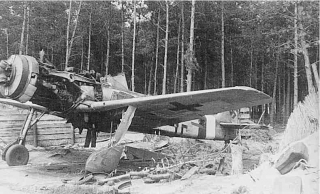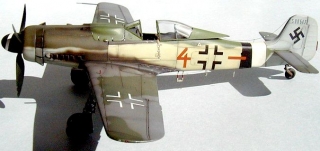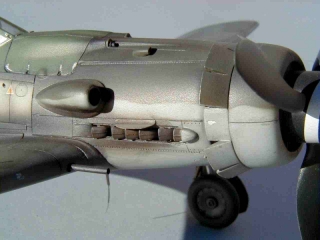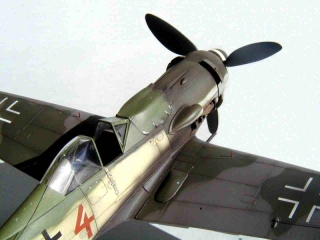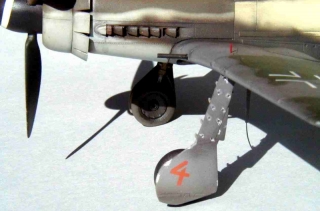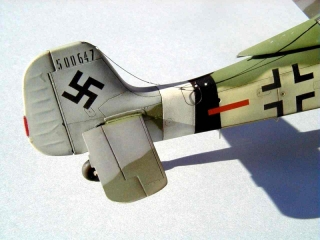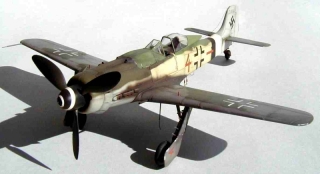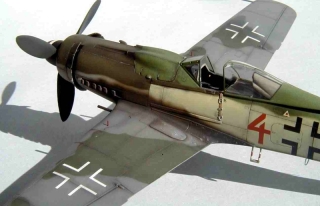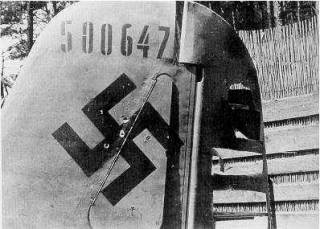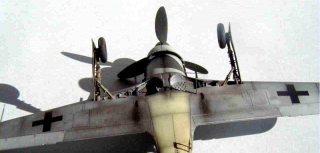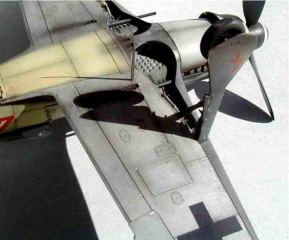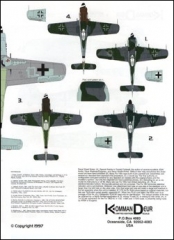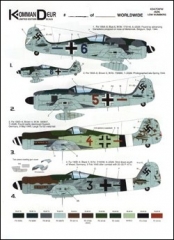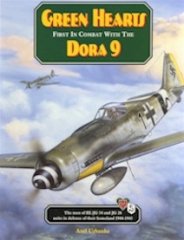Colour Profile by Claes Sundin
Photography by Mark L Tucker
B&W photographs courtesy of Eagle Editions
Background
This Fw 190D-9 “Brown 4” W.Nr.500647 of 7. Staffel, II./JG 26 was found by the Canadians at Hustedt airfield near Celle in mid-April 1945. It was one of 2 aircraft that had to be left behind when II. Gruppe JG26 abandoned the field on 10-11 April. Attempts by the Germans to destroy the aircraft were only partly successful.
What makes these photos special is that they provide further proof that there were Fw190D-9’s with the tail of the Ta152. Previously only one photo of such a D-9 was known, an aircraft of werknummer 500645.
The fact that 500647 is from the same Werknummerblock appears to prove that a small series of aircraft was built with this tail. Whether or not this was a result of a shortage of standard D-9 components must remain a matter of speculation.
DML/Dragon Fw 190D-12 1:48th Scale
The kit is the Dragon/DML/Trimaster offering. The D-12 Torpedo Flugzeug, another of the re-boxed Trimaster kits. Although only released by DML/Dragon in 1998 the moulds seem to have suffered from years of use.My example has numerous “blemishes”, “scratches” and some panel lines were almost non existent, especially around the tail area. Some of the smaller parts suffered from excessive flash and others were misaligned resulting in oval instead of circular cross sections.The “D-12” kit differs from the original “D-9” in that the D-12 aircraft has the taller Ta152 type tail, the upper cowling MG131 guns deleted, a large Jumo 213E type supercharger intake, large VS9 “paddle type” propellers and spinner and of course a big bloody torpedo to sling underneath!
Construction of the D-12 kit will have the standard DML D-9 type “flaws” ie: “the amazing banana fuselage” and the “whack a spreader in the fuselage” wing root problems.You will also have to contend with sanding flush the cannon access panels on the lower wing halves as the “insert” sits proud of the surface. It is only slightly raised but it sticks out like the proverbial “Canis testiculi” when you hit it with a coat of paint! After sanding of the blemishes on the tail I had to rescribe the lost panel line and rivet detail.As “Brown 4” is a “hybrid” D-9 I had to scavenge the various parts from another DML kit. I used the upper cowling that includes the MG131 guns from a D-9 kit as well as the smaller supercharger intake and the VS10 propeller and spinner.
The “smooth” type “non treaded” tires were modified kit items. I coated the kit wheels in Tamiya putty and Gunze Mr Surfacer. I then spun the wheel in an electric drill and sanded the tire smooth. Who needs a Dremel! Each tire was “flattened” to give it that “weighted” look! The undercarriage position indicators on the upper wings were made from stretched sprue.I replaced the kit plastic cannon barrels with items made from brass tube. The pitot tube was also made from brass tube and a hypodermic needle.I substituted the kit instrument panel with an Eduard PE and acetate one. The rudder pedals, seat belts and harness are Reheat items.
The antenna wire on D-9/11/12 series aircraft did not have a pulley type “tensioner” consequently when the canopy was open the antenna wire drooped and lay on the rear fuselage.This is a bastard to try and replicate. I tried numerous ways to do this this, stretched sprue, mono-filament thread, hair plucked from the wife’s head!, I can’t spare any from mine! I finally found some fine brass wire that I had stripped from the “shielding” around a coaxial TV cable. It is soft enough to bend and will stay “in shape”. It isn’t very malleable though, if you put a sharp kink in it it will snap very easily, as I found out at least 3 times!The resistors were made from drops of “Crystal Kleer” although “white glue” or Humbrol “Clear Fix” will also work.
For a detailed DML Fw 190 D-9 construction article see Brett Green’s Construction Feature on Hyperscale: DML’s 1:48 Fw190 D-9 Converted to a D-11
Camouflage & Colours of “Brown 4”
These colour “interpretations” of “Brown 4” were kindly supplied by Claes Sundin & E. Brown Ryle.
Although Claes’ colour scheme is different to that of Brown Ryle’s and both Claes and Brown’s differ from the profile of Jerry Crandall’s, as depicted in the “Green Hearts, First in Combat With The Dora 9″ book, I have included them as “options”. Who is right and who is wrong? Who the hell knows?! My “interpretation” of “Brown 4” is a conglomeration of all three schemes. Interpreting colour tones from 50 year old black & white photographs is not exactly a science, more akin to alchemy! Make up your own minds!
By 1944-45 German aircraft manufacturers were forced to disperse their construction and assembly facilities with various components being sub-contracted to smaller companies.This resulted in many completed components such as engines, main wings, tail assemblies and fuselages being delivered to final assembly areas with their markings and camouflage colours already applied.In the worsening war situation standardisation in the camouflage colours and schemes became superfluous, many variations and combinations in schemes became commonplace.
I painted the fuselage in a scheme of RLM 81 Braunviolet, RLM 82 Hellgrun, RLM 76 Lichtblau and the “spuriously designated” Grunblau 84. RLM 82 being the dominant colour along the top of the fuselage, was also sprayed around the horizontal stabiliser attachment points. The RLM 22 Schwarz and RLM 21 Weiss RVD bands were also masked and sprayed.Many arguments have been put forward over the years as to what the actual paint mix used to create “84” is, some have claimed it is poorly-manufactured RLM 76.For a more in-depth report on late war camouflage see David E. Brown’s “Commentary on the Evolution and Usage of Luftwaffe RLM Colours 81, 82 & 83”
The KommanDeur painting guide shows a mottle of RLM 81 Braunviolet sprayed on the tail and rudder.Frankly, I can’t see it on the photograph. It looks “weathered” to me. So I sprayed the tail RLM 76 Lichtblau and “dirtied” it up a bit. Again, I will leave it up to your own conclusion.I have sprayed the upper wings, as per the KommanDeur painting guide, in a scheme of RLM 75 Grauviolet and RLM 83 Dunkelgrun. If you study the photograph at the top of this page you will see that the upper wings are obscured anyway.The pattern chosen conforms to similar schemes seen on other late war D-9’s and for want of further references I have chosen to stick with it.
The fuselage underside, except for the engine cowl and tail, has been painted in “RLM 84” Grunblau. I painted the lower wing surface with Gunze Mr Metal Colour 218. This was to replicate a “natural metal” finish. I oversprayed with a mixture of Gunze Flat Clear and Tamiya Flat Base then “scrubbed” back the flat coat with some wet & dry to simulate an “oxidised” look.Several of the wing panels and control surfaces have been painted in a lighter colour possibly RLM 76 Lichtblau.
I again deviated from the KommanDeur painting guide. If you look at the B&W photograph at the top of the page you will notice that undercarriage doors appear to be “darker” than the RLM 76 Lichtblau patches on the undersurface of the wings.I had e-mailed Brown Ryle on this subject. His conclusion is the doors are possibly painted “dark” RLM 76. My conclusion is that the gear doors and the leading edge are over painted in the upper surface RLM 75 Grauviolet.Other D-9 series aircraft are seen with a similar finish, and there is also a colour photograph of an A-9 in Monogram Colour Guide to German Aircraft, page 40, top.I painted the spinner RLM 22 Schwarz with a RLM 21 Weiss decal for the spiral as was typical of 7 Staffel aircraft. The propeller blades were painted the standard RLM 70 Schwarzgrun.
Markings of “Brown 4”
The decals are from the KommanDeur “JG 26 Low Numbers” Limited Edition set. There are 4 decal sets for two Fw190A-8’s and 2 Fw190D-9’s of JG26:
- Fw190A-8, Blue 6, W.Nr. 175140, 8./JG26. Found by advancing Canadians propped on nose at Melsbroek, Belgium, Sept. 1944.
- Fw190A-8, Brown 5, W.Nr. 730995, 7./JG26. Photographed late Spring 1944. Pilot Uffz. Kurt Petzsch killed in this aircraft 25 Aug. 1944.
- Fw190D-9, Brown 4, W.Nr. 500647, 7./JG26. Found partly destroyed Hustedt, Germany, 8 May 1945. Note large Ta152 metal tail.
- Fw190D-9, Black 3, W.Nr. 210239, 6./JG26. Shot down south of Wesel, Germany, 9 Feb. 1945 after combat with 20-25 P-47s. A/C 70% damaged and subsequently “written off”.
These decals were fantastically thin and had almost no carrier film. All that was needed to ensure that they snuggled down into the panel lines was a little Super-Scale super-set. DO NOT use anything overly powerful on these decals, such as Gunze Mr Softer, or you might end up with them dissolving! I totally stuffed the upper wing B6 Balkenkreuz, it dissolved when I put the Gunze Mr Softer on it! I had put down some Super-Scale super-set to aid “slippage” I think the Mr Softer was “overkill”. Now if they could only make prophylactics as thin as these decals!
“Brown 4” displays the simplified national markings common to many late war aircraft. The lower wing has the simplified B1b Balkenkreuz applied with the Hakenkreuz on the tail fin being of the H3 type. Much of the stenciling normally applied to D-9’s appears to have been omitted on this aircraft, possibly to save resources. It is probable however that some yellow octane triangles were displayed.
The white spinner spiral is not supplied, I don’t think Brown Ryle could have fit any more decals on the sheet! You will need to source one from either the “spares box” or Cutting Edge make a set of “generic” Fw 190A/D spirals in both black and white.
After all the decals were applied I “weathered” the aircraft using a number of techniques. The “Green Method”, pre-shading, the “Wauchop Method”, post-shading and the “Tucker Method”, sanding off your mistakes and starting again!
The panel lines were given a wash of “blacky, browny” acrylic paint mixed with water. The exhaust and cordite stains are a mixture of the same “blacky, browny” acrylic paint airbrushed on. I used a little Tamiya X-11 Chrome Silver mixed with Tamiya X-2 White to simulate scratches of “bare metal”. I then airbrushed the entire aircraft with Microscale Micro Flat and gave it a light “dusting” with some Tamiya XF-64 Red Brown.
Paint Colours Used In Construction
The model was airbrushed using various Gunze Sangyo Acrylics, straight from the bottle. No blending, mixing or stuffing around, a little Tamiya Acrylic Thinner, about a 50% mix and that’s it! The Gunze Mr Metal Colour buffable metalliser was thinned with “All Purpose Thinner”.
Below is a list of the paint codes:
| RLM Colour | Gunze Acrylics |
| RLM 70 Schwarzgrun | H65 |
| RLM 75 Grauviolet | H69 |
| RLM 76 Lichtblau | H417 |
| RLM 81 Braunviolet | H421 |
| RLM 82 Hellgrun | H422 |
| RLM 83 Dunkelgrun | H423 |
| RLM 84 Grunblau | H74 |
| Natural Metal | Mr Metal Colour 218 |
Conclusion
I have no idea how many hours were spent in making this kit, it seemed like bloody ages! I think this will be my last DML/Dragon D-9 though. I will use the Tamiya D-9 kit for my JV44 “project”. Even though the Tamiya kit suffers from some “inaccuracies” I think that the ease of construction make it a better proposition than the DML/Dragon kit.
Eagle Parts have released a D-9 update and D-11 conversion set for the Tamiya kit. These include new wheels, prop hub, pitch collars, prop blades, spinner, backing plate, prop shaft and gun cowl for the D-9. The D-11 conversion includes a new gun deck cowling, VS 10 props, spinners, spinner back plate, metal prop shaft, prop pitch mechanisms, plug for intake cut-out, supercharger intake, cannon breach covers and right & left cannon access panels. Am I getting lazy? Probably. Older and crankier? Definitely!
I would like to thank E. Brown Ryle from KommanDeur, Claes Sundin, Jerry Crandall from Eagle Editions and Brett Green for their assistance in the “Brown 4” Project.
Eagle Editions Ltd
As I had mentioned previously I used the Eagle Editions Ltd book, “Green Hearts, First in Combat with the Dora 9” by Axel Urbank as a reference during the construction of “Brown 4”. This is a fantastic reference book not only visually but the narrative is also enthralling.
The book deals with the men of III./JG 54 and JG 26 as they unite in defence of their homeland, 1944-1945. Over 300 pages of late war day to day combat stories, this book features over 250 photos including about 40 NEW Dora 9 aircraft never before published!
Also, full colour profiles by Jerry Crandall & Tom Tullis, updated D-9 drawings, loss lists, personnel lists and more.
I suggest that all “Doraphiles” grab a copy. If you only use this one book as a reference you will be building D-9’s until the cows come home!
For a more in depth look at this book check out Brett Green’s review on Hyperscale.
References
- Monogram Close-Up 10 – Fw 190 D by J. Richard Smith and Eddie J. Creek, Monogram Aviation Publications, Massachusetts, 1986 ISBN 0-914144-10-3
- Squadron/Signal Publications – Fw 190D Walk Around by E. Brown Ryle and Malcolm Laing, Squadron Signal Publications, Texas, 1997 ISBN 0-89747-374-4
- KommanDeur “JG 26 Low Numbers” Limited Edition decal set
- Green Hearts, First In Combat With The Dora 9 by Axel Urbank , Eagle Editions Ltd, Massachusetts, 1998 ISBN 0-9660706-1-5
- A bucket load of pestering email questions, clarifications and suppositions.
Model, Model Photographs and Article Copyright © 1998 by Mark Tucker
Black & White photographs courtesy of Eagle Editions Ltd
Colour Profile Copyright © 1998 by Claes Sundin

